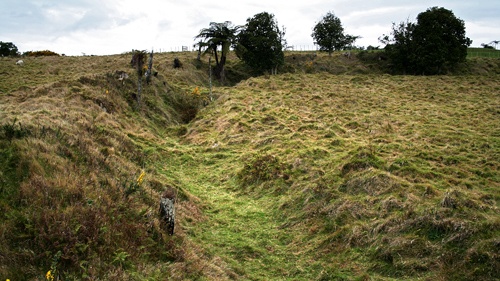
Pukerangiora Pā Historic Reserve (1821-22)
A palimpsest etched in blood
Although we think of the First World War as our most costly in terms of human life, the Germans and the Turks spilled less New Zealand blood than the ‘New Zealanders’, as the British called the Māori, did fighting each other in the Musket Wars of the early 1800s. Historian James Belich accuses us of indulging in ‘historical amnesia’ over the New Zealand Wars. In fact we lobotomised ourselves to erase this earlier conflict, which covered more territory, caused more cultural disruption and claimed many more lives than the later wars. Yet ignore it we do. The fiercest fighting took place between 1818 and 1836. Body counts are hazy. The Oxford companion to New Zealand military history says that ‘between 20,000 and 30,000 may have died either in battle or of disease (with one estimate putting the mortality as high as 80,000)’ – about 20% of the estimated Māori population, even at the lower end of the range. While some historians question the accuracy of the ‘musket’ part of the wars’ name, it appears to have stuck.
The name Pukerangiora now covers several sites and a lot of military history. It was besieged twice during the Musket Wars. In 1821 a taua led by Tūkorehu of Ngāti Maniapoto was besieged here for seven months by Te Ātiawa, who surrounded it with earthworks and palisading, adding insult to injury by dubbing the siege ‘Raihe Poaka’ (the penned-up pigs). Blood flowed here again a decade later. Te Ātiawa, weakened by recent emigration to join Te Rauparaha in the Cook Strait area, holed up at Pukerangiora after a large Waikato taua descended on North Taranaki. When the pā fell after a three-month siege, as many as 1200 may have died.
Ironically, Pukerangiora is probably better known for its role in the First (1860-61) and Second (1863-66) Taranaki Wars. The first was the major fight. After their defeat at Puketakauere government forces generally avoided pā, which they knew were there to lure them into attacking, but as the campaign ground on they decided to destroy Te Ātiawa strongholds south of the Waitara. In ‘Pratt’s Sap’, forces under Major-General T.S. Pratt tunnelled laboriously up the slopes towards a new pā, Te Arei (‘the barrier’), erected in front of freshly strengthened Pukerangiora. Te Ātiawa chief Hapurona commanded both. Pratt built eight redoubts and dug two stretches of sap (covered trench). Maori counter-attacked, most famously against number three redoubt on the night of 23 January, suffering heavy casualties in the crossfire between the redoubts. Working under cover of large sap rollers and supported by artillery fire, the British advanced. By March 1861 number eight redoubt was just 75 m from Te Arei pā, which was taking a heavy pounding. Hapurona wisely sought a truce. In a ‘settlement’ disliked by both sides, the Waikato and southern Taranaki tribes withdrew. An uneasy peace descended on Taranaki.
The Second Taranaki War was a sideshow to the Waikato campaign, but Te Arei was briefly again the site of conflict. On 11 October 1864, under cover of thick fog, Colonel H.J. Warre took it. Shots were fired but the defenders quickly withdrew. A redoubt was built quickly but abandoned about three years later. A blockhouse relocated to the other side of the road in 1869 was manned for about a year. Since then sheep have grazed the site. Cultivation destroyed about a third of Pukerangiora but since 1910 the rest has been a Crown reserve, now managed by DOC.
Further information
This site is item number 10 on the History of New Zealand in 100 Places list.
On the ground
The site is signposted.
Websites
- Department of Conservation site info
- Thomas Pratt biography – Te Ara
- New Zealand Wars - Te Ara
- The wars of Waitara - Roadside Stories (video)
Books
- R.D. Crosby, The Musket Wars, Reed Books, Auckland, 1999
- David Green, Battlefields of the New Zealand Wars: a visitor’s guide, Penguin, Auckland, 2010





Community contributions